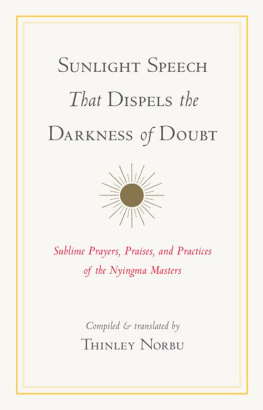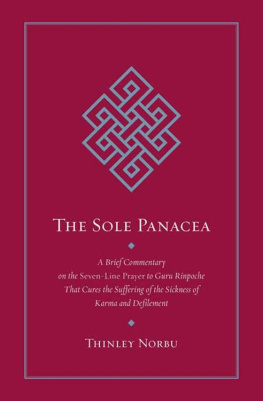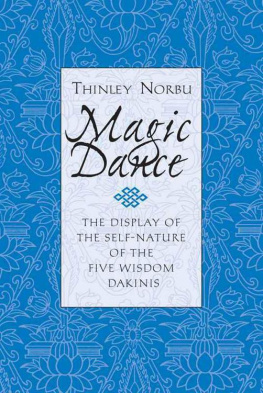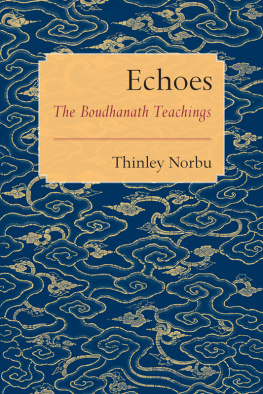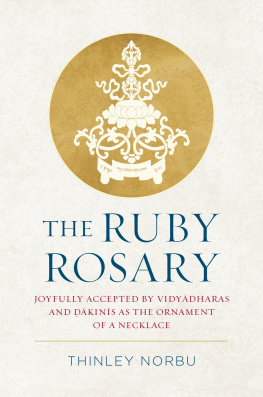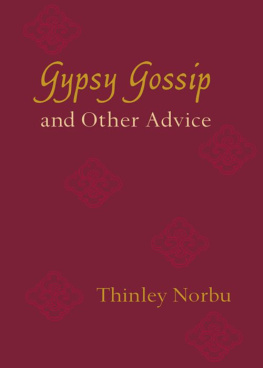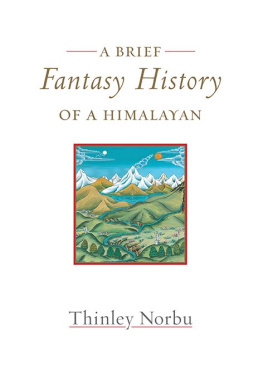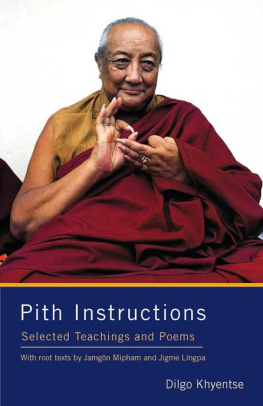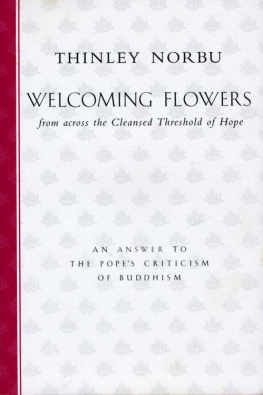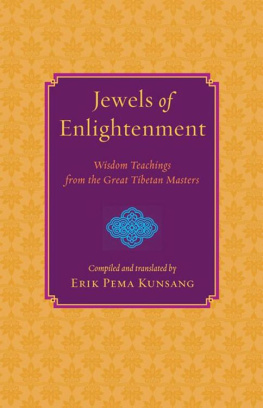I hope that whoever reads this book will do so with faith and the prayer to make a connection with the teachings it contains so that Buddha nature will blossom. We should recognize that it is not just paper and ink, but blesses our minds to open toward enlightenment. Read it with faith, increasing minds qualities. It is the same as Buddhas speech.
from the Introduction by Kyabje Thinley Norbu Rinpoche
ABOUT THE BOOK
From the noble lotus pond of pure conduct,
The swan of intelligence calls.
By the white wings of the three practices of the teachings,
May all wise sentient beings be happy.
Kunkhyen Longchenpa
With the wish to inspire and motivate practitioners, Kyabje Thinley Norbu Rinpoche has translated a selection of wisdom teachings into direct and simple English that retains the power of the original writings and their emphasis on practice. The authors are five of the most sublime scholar-saints of the Nyingma lineage of Tibetan Buddhism: Kunkhyen Longchenpa, Kunkhyen Jigme Lingpa, Patrul Rinpoche, Mipham Rinpoche, and Kyabje Dudjom Rinpoche. Their compositions include words of advice, poetic praises, concise daily prayers, and liturgies accompanied by instructions, written over a span of time from the medieval to the modern era. These precious teachings are intended to be the cause of faith, practice, and enlightenment.
THINLEY NORBU RINPOCHE (19312011) was a preeminent teacher in the Nyingma school of Tibetan Buddhism. The eldest son of His Holiness Ddjom Rinpoche, he was a primary holder of the Ddjom Tersar lineage and considered to be an emanation of Longchenpa, the great fourteenth-century Nyingma master.
Sign up to receive weekly Tibetan Dharma teachings and special offers from Shambhala Publications.

Or visit us online to sign up at shambhala.com/edharmaquotes.
SUNLIGHT SPEECH That DISPELS the DARKNESS of DOUBT
Sublime Prayers, Praises, and Practices of the Nyingma Masters
Compiled and translated by THINLEY NORBU
Written by the Omniscient Emanations of Buddha
K UNKHYEN L ONGCHENPA
R IGDZIN J IGME L INGPA
P ATRUL R INPOCHE
M IPHAM R INPOCHE
K YABJE D UDJOM R INPOCHE

Shambhala
BOSTON & LONDON
2015
Shambhala Publications, Inc.
Horticultural Hall
300 Massachusetts Avenue
Boston, Massachusetts 02115
www.shambhala.com
2015 by the Estate of Kyabje Thinley Norbu Rinpoche
Cover art by Tulku Jamyang
All rights reserved. No part of this book may be reproduced in any form or by any means, electronic or mechanical, including photocopying, recording, or by any information storage and retrieval system, without permission in writing from the publisher.
LIBRARY OF CONGRESS CATALOGING-IN-PUBLICATION DATA
Sunlight speech that dispels the darkness of doubt: sublime prayers, praises, and practices of the Nyingma masters / by the omniscient emanations of Buddha, Kunkhyen Longchenpa, Rigdzin Jigme Lingpa, Mipham Rinpoche, Paltrul Rinpoche, Khyabje Ddjom Rinpoche; Translated by Thinley Norbu.First edition.
pages cm
Includes bibliographical references.
Includes translations from Tibetan.
eISBN 978-0-8348-0092-2
ISBN 978-1-57062-244-1 (hardcover: alk. paper) 1. Rin-ma-pa (Sect)Doctrines. I. Klon-chen-pa Dri-med-od-zer, 13081363. II. Thinley Norbu, translator.
BQ7662.4.s86 2014
294.3420423dc23
2014007265
Contents
THINLEY NORBU
MIPHAM RINPOCHE
KUNKHYEN LONGCHENPA
JAMYANG KHYENTSE WANGPO
KYABJE DUDJOM RINPOCHE
PATRUL RINPOCHE
RIGDZIN JIGME LINGPA
RIGDZIN JIGME LINGPA
KUNKHYEN LONGCHENPA
RIGDZIN JIGME LINGPA
MIPHAM RINPOCHE
KYABJE DUDJOM RINPOCHE
PRAYER MIPHAM RINPOCHE
KYABJE DUDJOM RINPOCHE
KYABJE DUDJOM RINPOCHE
KYABJE DUDJOM RINPOCHE
The portraits of Kunkhyen Longchenpa (first) and Rigdzin Jigme Lingpa Rinpoche (second) that appear in chapter 2 are reproductions of two small, cherished personal thangkas belonging to Kyabje Thinley Norbu Rinpoche, who took them everywhere in an altar suitcase, even on flights. They were painted by a thangka artist in Bhutan who was known for having a special gift, or kabap ( bka babs ), for painting these two sublime beings, and they are considered to be actual likenesses of these masters from centuries past.
Italics have been employed in a special way in this book (in addition to their usual use for titles of works). They are used in sadhanas to distinguish instructions and commentary from the text to be recited. For example:
Chapter 6, The Treasure of Blessings of the Ritual of Buddha, contains italicized portions that are mainly instructions by Mipham Rinpoche, the author of the puja, except for one interpolation in brackets (Also by Mipham Rinpoche, added by Kyabje Thinley Norbu Rinpoche).
Chapter 7, The Sadhana of Fully Enlightened Supreme Vajrasattva, Called The Daily Practice of the Profound Path, Contained in Essence, contains italicized instructions, which are not to be recited by the practitioner.
Chapter 8, The Rain of Blessings: Guru Yoga in Connection with the Seven-Line Prayer, contains italicized portions that are instructions and commentary by the author, Mipham Rinpoche.
Chapter 11, The Guru Yoga of Receiving Wish-Fulfilling Great Flawless Exaltation, contains italicized portions that are instructions and commentary by the author, Kyabje Dudjom Rinpoche.
Until the occupation of Tibet by the communist Chinese, there were many great sublime saints in that land among the lineage holders of the Nyingma tradition of Buddhism. Some of the most precious of these saints were Gyalwa Longchen Rabjam, Kunkhyen Jigme Lingpa, Patrul Rinpoche, Mipham Rinpoche, and Kyabje Dudjom Rinpoche, whose writings are contained in this book.
Originally, Sandra Scales requested that I translate Mindfulness, the Ocean of Qualities by Rigdzin Jigme Lingpa, and this was done with her assistance. Also included in this book are The Practice of the View, Meditation, and Action, Called The Sublime Heart Jewel by Patrul Rinpoche; a revision of a translation I did many years ago of The Lions Roar by Rigdzin Jigme Lingpa; and Always Rejoicing in the Forest , by Kunkhyen Longchenpa. This book also contains translations of several prayers and sadhanas, including Praise of the Ten Deeds of Buddha by Rigdzin Jigme Lingpa; The Treasure of Blessings of the Ritual of Buddha and The Rain of Blessings: Guru Yoga in Connection with the Seven-Line Prayer by Mipham Rinpoche; and The Sadhana of Fully Enlightened Supreme Vajrasattva, Called The Daily Practice of the Profound Path, Contained in Essence; The Assembly Palace of Great Flawless Exaltation, Radiant Lotus Light; Calling the Lama; and The Guru Yoga of Receiving Wish-Fulfilling Great Flawless Exaltation by Kyabje Dudjom Rinpoche.
In general, when translating any Buddhist teachings from Tibetan into English, especially precious wisdom teachings, there is a language problem, since it is difficult to connect substantial, nihilist, ordinary expressions with insubstantial wisdom expressions. Dharma words are connected to mind, mind is connected to wisdom, and wisdom is intangible. Therefore, whoever translates Dharma must try predominantly to write about the intangible qualities of wisdom. So it is awkward and not such a good idea to translate these teachings into English, since English is predominantly a materialistic language that does not have suitable words for the profound, intangible appearance of qualities completely revealed by Tibetan terms. If words are chosen with the misinterpretation of substantial word habit, these qualities can be turned into ordinary intellectual, philosophical, or material conceptions. For those who like to study or practice Buddhism, it is of great benefit to learn literary Tibetan rather than reading translations, since it is the most vast and profound language in the world in this generation for conveying pure spiritual meaning.
Next page
